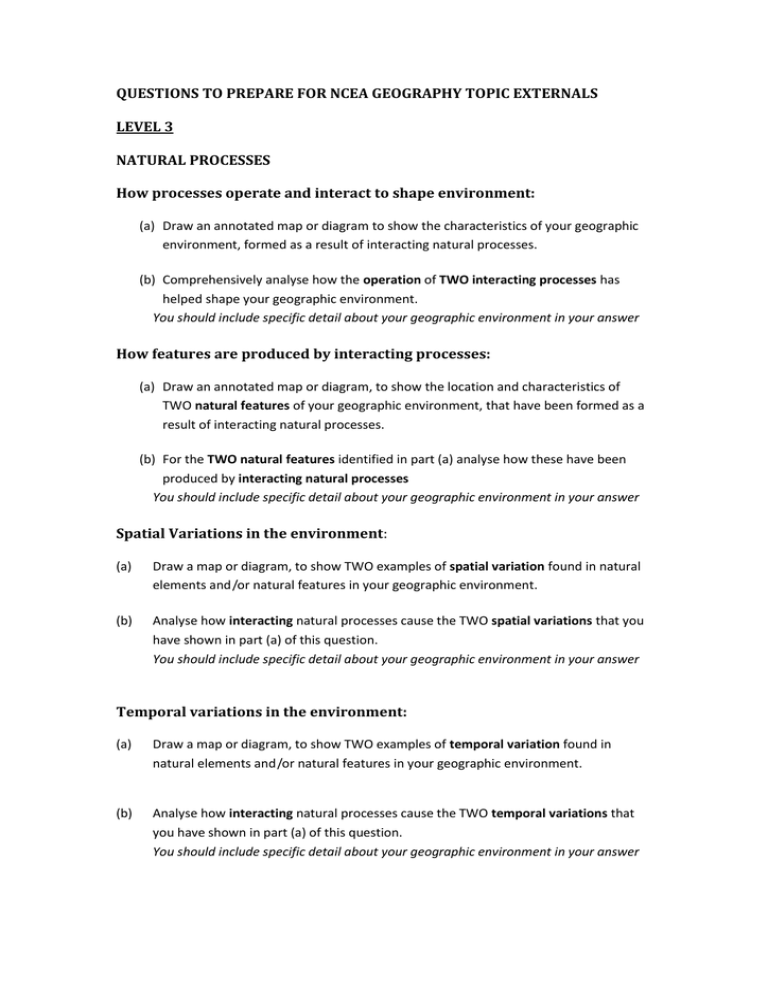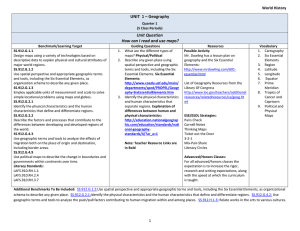QUESTIONS TO PREPARE FOR L3 NCEA GEOGRAPHY TOPIC
advertisement

QUESTIONS TO PREPARE FOR NCEA GEOGRAPHY TOPIC EXTERNALS LEVEL 3 NATURAL PROCESSES How processes operate and interact to shape environment: (a) Draw an annotated map or diagram to show the characteristics of your geographic environment, formed as a result of interacting natural processes. (b) Comprehensively analyse how the operation of TWO interacting processes has helped shape your geographic environment. You should include specific detail about your geographic environment in your answer How features are produced by interacting processes: (a) Draw an annotated map or diagram, to show the location and characteristics of TWO natural features of your geographic environment, that have been formed as a result of interacting natural processes. (b) For the TWO natural features identified in part (a) analyse how these have been produced by interacting natural processes You should include specific detail about your geographic environment in your answer Spatial Variations in the environment: (a) Draw a map or diagram, to show TWO examples of spatial variation found in natural elements and /or natural features in your geographic environment. (b) Analyse how interacting natural processes cause the TWO spatial variations that you have shown in part (a) of this question. You should include specific detail about your geographic environment in your answer Temporal variations in the environment: (a) Draw a map or diagram, to show TWO examples of temporal variation found in natural elements and /or natural features in your geographic environment. (b) Analyse how interacting natural processes cause the TWO temporal variations that you have shown in part (a) of this question. You should include specific detail about your geographic environment in your answer CULTURAL PROCESS How the process operates to shape the environment (a) Draw maps or diagrams to show how your chosen cultural process operates to produce different characteristics in ONE named geographic environment. (b) Comprehensively analyse how your chosen cultural process operates to produce specific characteristics in your chosen environment(s). You should include specific case study detail about your geographic environment(s) in your answer. How the process interacts on people and the environment (a) Draw maps or diagrams to show how your chosen cultural process has affected people and the environment in ONE named geographic environment. (b) Comprehensively analyse how your cultural process has affected people and the environment in different ways in your chosen environment(s). You should include specific case study detail about your geographic environment(s) in your answer. How the process creates spatial variations: (a) Draw maps or diagrams to show how the characteristics of your cultural process show spatial variation in ONE named geographic environment. (b) Comprehensively analyse the causes of the spatial variation that have resulted from the operation of your cultural process in your chosen environment(s). You should include specific case study detail about your geographic environment(s) in your answer. How the process produces temporal variations: (a) Draw maps or diagrams to show how the characteristics of your cultural process have changed between TWO identified time periods in ONE named geographic environment. (b) Comprehensively analyse the causes of the temporal variations that have resulted from the operation of your cultural process in your chosen environment(s). You should include specific case study detail about your geographic environment(s) in your answer.




